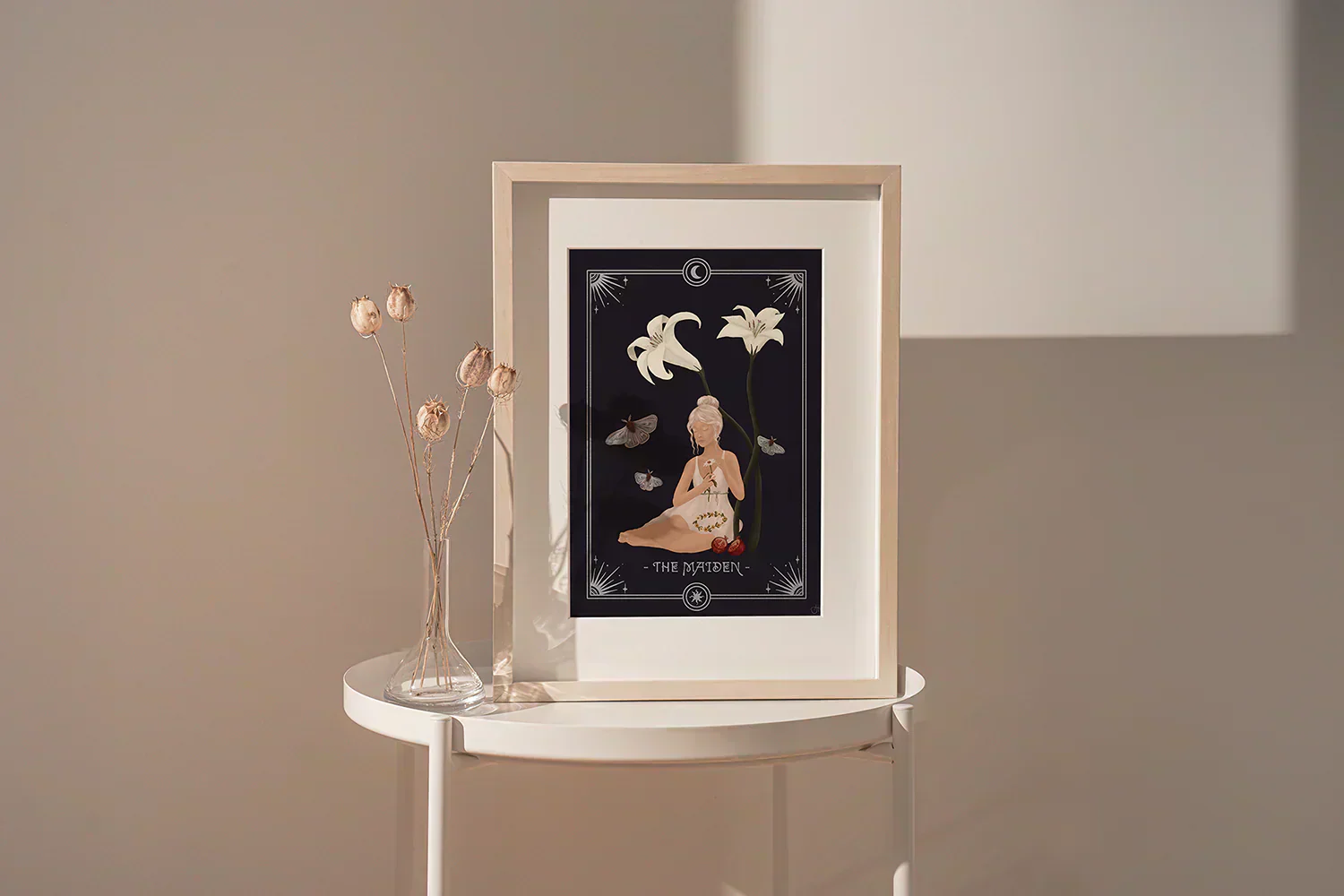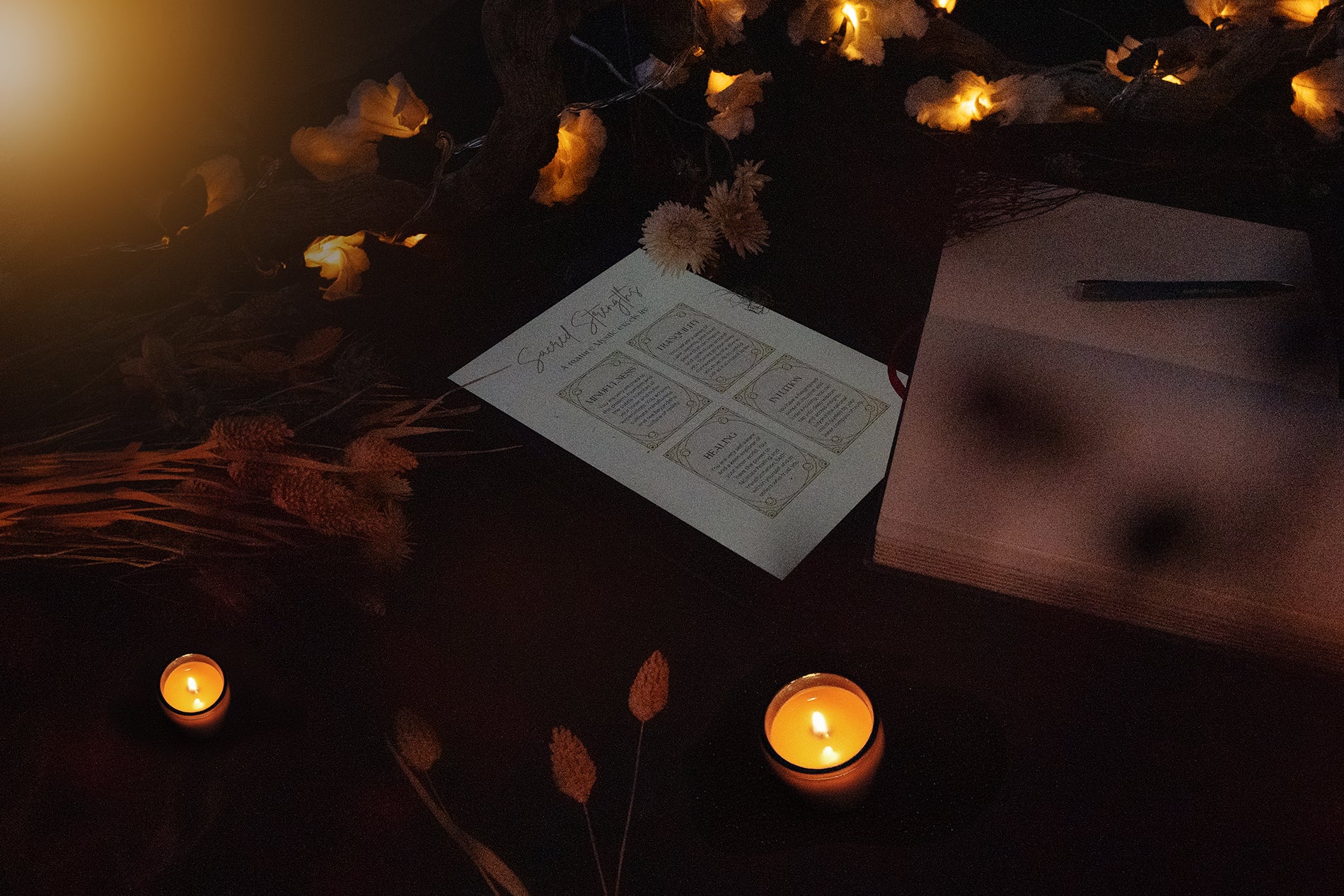
It's hard not to like the Maiden – with her sweet, good-hearted nature, she wins over people almost instantly. In myths and fairy tales, the Maiden archetype often shows up as the innocent girl, the princess, the dreamer.
If you're familiar with mythology, you'll recognize her in the triple goddess motif (Maiden–Mother–Crone), representing the three stages of feminine life. Across cultures, the Maiden represents youth, innocence, new beginnings, springtime, and potential. In cinema, she appears as the so-called ingénue: the wide-eyed, innocent heroine whose story is shaped by curiosity and sweetness.
Symbolically, the Maiden represents a stage we all know: the powerful (and often vulnerable) journey of coming into our own. She carries both the lightness of new beginnings and the lessons that come when innocence meets the real world.
The Maiden archetype's greatest gifts
The Maiden looks at the world differently – with an unparalleled sense of wonder. To her, every day is a new discovery, her spirit still unspoiled by the heavier burdens of life. She trusts people easily and carries a deep faith that life will unfold in her favor. Deep down, she fervently believes in happy endings.
In the Maiden, our inner child lives on. She is the first one to burst into a spontaneous giggle and often brings a sense of playfulness to situations that many adults forget can be fun. Her lighthearted spirit reminds others that joy doesn’t need a reason and can even soften tension (something she gladly takes on as she can’t help wanting everyone to get along).
Since this feminine archetype is tied deeply to the cycles of life, the Maiden also embodies the principle of impermanence and transformation. Everything changes, all the time, nothing stays the same – and the Maiden is a lot better at embracing this natural flow of life than others. New beginnings don't scare her, and she views them with curiosity rather than fear. For her, change is an invitation to discover parts of herself she hasn’t met yet.
The Maiden is a dreamer at heart, carried by big visions of what life could be. Her enthusiasm is contagious, often inspiring others simply by the brightness of her energy. She sees the world not as it is, but as it might become.
At the same time, she’s a sensitive soul, attuned to things others overlook and full of deep feelings. Her openness heightens her awareness of subtle shifts in energy and emotion, giving her a natural intuition, though it also leaves her vulnerable. In this emotional rawness, she is very authentic. The Maiden rarely hides her true self (nor does she try to) – she simply shows up as she is.

The Maiden archetype's shadow
In her essence, the Maiden represents the spirit of a young girl, which comes with a certain vulnerability. As a natural optimist, the Maiden wants to trust everyone, always seeing the good in people. However, if this per se positive trait crosses into naivety, it puts her at risk of being taken advantage of, especially since she might find it difficult to speak up for herself.
In general, she may not have learned to fully take agency over her own life yet. The Maiden in her shadow tends to be passive, letting other people and circumstances control her fate rather than taking things into her own hands. This can happen because she’s still unsure of what she truly wants, or because she’s avoiding the weight of responsibility.
This struggle with taking serious decisions for herself may go hand in hand with a general sense of insecurity, often manifesting in self-doubt, hesitation, or a tendency to try to please everyone. For the Maiden, growth often looks like getting to know herself, her own opinions and desires, and learning to trust her strengths.
If she continues to avoid responsibility, the Maiden risks slipping into a victim mindset, recycling the same old limiting beliefs – “I can’t,” or “this always happens to me.” What she often forgets is that we have far more control over our lives than she tends to give herself credit for. The whole “damsel in distress” vibe is only cute for so long. To truly mature, she must recognize that no one is coming to rescue her, and that handing her power over to others only keeps her stuck.
Many of the shadow traits of the Maiden are typical for our younger years and they often fade when we become more secure in ourselves or face the first serious period of personal growth.
As a Maiden, the path to integrating your shadow may look like:
- learning to trust your own voice
- making decisions for herself without being influenced by others
- seeing responsibility not as a burden but as freedom
- setting boundaries and protecting her energy
- growing more discerning while still holding firmly to the goodness in your heart
- freeing herself from limiting beliefs
If you’re ready to integrate this archetype, the guided prompts in the Maiden Workbook will walk you through it, helping you explore your own patterns and transform them into strength.
The Maiden in mythology: Persephone
The classic maiden tale is found in the story of Persephone, also Kore, who is both the Greek goddess of spring and fertility as well as the Queen of the Underworld, goddess of death – a very interesting combination, looking at how she represents both the beginning and the end.
In her younger years, she is a victim: While picking flowers, the maiden Kore is abducted by Hades, God of the Underworld, who wants her as his consort. Her mother's, Demeter's, grief caused the earth to wither until Zeus demanded Persephone’s release. But Persephone had eaten pomegranate seeds offered by Hades, binding her to his realm. That act, sometimes framed as accidental, sometimes choice, marked her initiation and transformation, leading her to step into a more powerful role. A compromise was made: she spends part of the year with her mother above, bringing growth, and part below with Hades, ruling the underworld.
This agreement symbolically explains the cycles of seasons: When Persephone returns to earth, everything comes to bloom (spring), when she disappears back into the underworld, her mother's grief turns the world barren again (winter). That's why we associate Persephone both with light and darkness, beginnings and endings – she is the embodiment of the never-ending change and transformation we go through in life.
List of Maiden archetype examples
In mythology: Kore/Persephone (Goddess of Spring, Queen of the Underworld), Brigid (Celtic spring/maiden goddess), Hebe (Greek goddess of youth), Blodeuwedd (Welsh maiden figure created from flowers), Saraswati (mainly Sage, but also connected to purification/virgin goddess), Iðunn (Norse goddess of youth & rejuvenation)
Real-life examples: Audrey Hepburn, Saint Bernadette of Lourdes, Princess Diana (in her younger years), Grace Kelly, Reese Witherspoon, Emilia Clarke, Taylor Swift (early years), Drew Barrymore
In fiction: Most Disnesy princesses (Rapunzel, Cinderella, Snow White, ...), Anne Shirley (Anne of Green Gables), Phoebe (Friends), Jessica Day (New Girl), Ophelia (Hamlet), Cosette (Les Misérables), Eliza (My Fair Lady), Catherine Morland (Northanger Abbey), Marianne Dashwood (Sense and Sensibility), Sophie (Mamma Mia!)
Psychological & developmental
I've observed that many adult women hesitate to identify with the Maiden, likely because she’s so strongly tied to innocence, playfulness and dependency, traits our culture often dismisses once we reach adulthood. (It's actually also my least popular workbook, even though there is so much value in it.) We’ve all lived through the Maiden stage, yet, embracing her as an ongoing archetype can feel uncomfortable, as if claiming her means denying maturity. Yes, the Maiden is typically found in adolescence, but she isn’t limited to it, nor does she have to carry her shadow traits of naiveté or insecurity. At her core, she embodies renewal, openness, curiosity, and the courage to step into the unknown, qualities that matter at any age. Whenever we begin again, the Maiden is quietly present.
In relationships
The Maiden brings playfulness and romance into love. She approaches relationships openly, seeing the best in people and believing in possibility. At her best, she is light-hearted and willing to grow alongside her partner. The challenge lies in building confidence in her own voice, so her openness becomes a strength rather than a vulnerability.
Career
The beautiful thing about the Maiden: She is open to any option, can envision so many paths for herself. No matter the environment, she is quick to adapt and typically brings a breath of fresh air into into projects, unafraid to ask questions or challenge stale patterns. Whenever we learn, see with beginner's eyes again, the Maiden is active.
Personal growth
The Maiden archetype can help you to:
- embrace change and inner transformation
- explore your interests, your body, your purpose
- heal your inner child
- stay open, curious and receptive
- let your instincts guide you toward your dreams
- take risks and explore new options in life
- express your creativity
- invite more play into your life
The Maiden archetype holds so much wisdom for those willing to explore her gifts and challenges. By understanding her, you begin to see how your own sensitivity, trust, playfulness, and sense of wonder can be powerful guides rather than obstacles.
If you’d like to dive deeper, I created the Feminine Archetype Workbooks, which offer guided reflections and practical exercises to work with archetypes in a more personal and transformative way.
Wherever you are on your journey, may the Maiden remind you that every new season of change carries its own quiet magic. ✨

Continue the journey
Grow with the archetype workbooks
The Feminine Archetype Workbooks are gentle companions for self-reflection and personal growth. Each one offers prompts, insights, and exercises to help you become the woman you were always meant to be. If you’re curious to explore what these archetypes might awaken in you, let the workbooks guide you into deeper alignment with your most authentic self.
Quick navigation
2 comments
Hi St.eve,
yes, the Sage archetype is pretty high in masculine energy, I see it as quite similar to the masculine-coded Magician archetype! The Sage definitely needs some balancing (it’s one of my dominant archetypes, too) – getting out of the mind, and into the heart and body. So the work you’re doing sounds spot on! The Maiden can really help us get in touch with our vulnerable side, intuition and that beautiful sense of wonder that counterbalances the logic-forward approach of the Sage. Not everything needs to be explained or understood, sometimes it’s beautiful to just witness in awe.
All the best to you,
Anna
thanks for the insights- my test showed Sage as my archetype (quite masculine) however, I am really drawn to the Maiden archetype as well, given that I have been going through a transformation of exploration of my feminine psyche, being much more vulnerable and getting in touch with my own sensuality and body. i wonder what that combination of archetypes means?